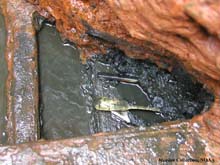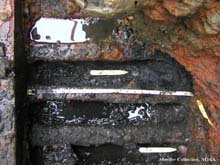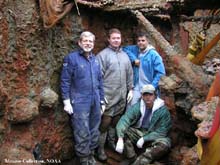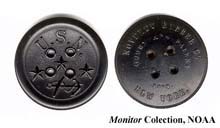
A bone knife handle, a silver fork and a silver spoon lying on the roof rails. Numerous pieces of flatware have been recovered from this area. Click image for larger view and detailed explanation.

Two hard rubber US Navy buttons are documented and photographed in situ prior to recovery. These buttons are associated with the wool coat that was recovered from inside the turret several weeks ago. Click image for larger view and detailed explanation.
In the Monitor's Turret
November 5, 2002
Jeff Johnston
Monitor National Marine Sanctuary
For the period of October 21 - 31, 2002
During the past several days, personnel from NOAA and The Mariners' Museum working in the turret have watched the mud level in the turret come down significantly. We have now cleared the turret of 95 percent of all the deep mud. We found few significant artifacts in the upper sediment layers, but as in the other areas of the turret, we did not expect to find many. The cultural material layers of small artifacts encountered thus far have all been at the depth of the inverted roof.
We continue to find silver flatware between the roof rails. Several pieces have now undergone preliminary conservation, revealing a variety of engraved initials. Research is underway to match up the initials with crew members from the ship.
Four more hard rubber US Navy buttons also were uncovered in an area between the roof rails. The location of the buttons indicates that they are associated with the wool coat that was removed from the turret several weeks ago (see Aug 30 log). There were no buttons still attached to the coat, and we had hoped that they would be found further down in the sediment. We were right.
As of October 30, we have recovered and tagged more than 400 artifacts from the turret excavation.
Now that the majority of the turret is cleared of sediment, we allowed the media an opportunity to climb down in the turret and see the excavation process and progress. Click here to see the coverage of the turret excavation in the Daily Press and here to see coverage in the Virginian-Pilot.
Everyone who has had the opportunity to stand in the Monitor's gun turret is as awed by it as we are. One reporter commented that it was probably "old hat" to us, now that we have been inside for so long. We quickly corrected him. Everyday inside the Monitor's turret is a fascinating day.
As more and more of the sediment, coal, and concretions are removed, we find more and more details about the lives of the men that were onboard. I see new details every time I study the areas around me. "Old hat?" No way! If only these iron walls could talk.

The Turret Excavation Team (l. to r.) Dr. John Broadwater, manager MNMS/underwater archaeologist; Tane Casserley, underwater archaeologist, MNMS; Wayne Lusardi, archaeological conservator, The Mariners’ Museum; and Jeff Johnston, program specialist and historian, MNMS. Click image for larger view and detailed explanation.
Sign up for the Ocean Explorer E-mail Update List.


































